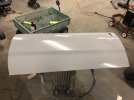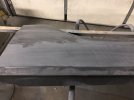jcmeyer5
Having fun learning!
Real quick, this is a door that I stripped, epoxied, filled, epoxied, filled again, epoxied, sanded out nibs, then shot with 3 coats of Featherill G2. The Featherfill went on 3 weeks ago. Today I decided I wanted to sand it... so I did. Using 150 grit I block sanded the entire door. I used black Featherfill and it guidecoated itself well. I blocked until I had no Featherfill untouched. I was consistent across the panel. I broke through to primer in a couple spots, filler in others, and some metal in one tiny spot along the edge of the door.
I FEEL like this grit is done, and that I should switch to 180/220 to smooth things out for final primer. But this is my first go at it, and maybe I’m wrong? I really am not trying to rush it... just don’t know any better. How do I know when I am done blocking?
I FEEL like this grit is done, and that I should switch to 180/220 to smooth things out for final primer. But this is my first go at it, and maybe I’m wrong? I really am not trying to rush it... just don’t know any better. How do I know when I am done blocking?
Last edited:


